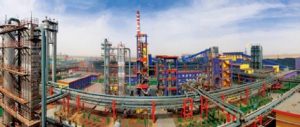The world's newest carbon citadel rises up between the blasted deserts of Inner Mongolia and the coal-black lands of Shaanxi province.
Ordos is a city that few outside China know. But the future of global emissions, and global warming looks increasingly more likely to be set in industrial powerhouses like this than in the negotiating halls of Copenhagen.
While the world's countries struggle to reach a treaty to defeat climate change, Chinese miners and scientists here are ramping up production and finding new ways to burn and bury carbon that will shape the policies of the world's biggest polluting nation.
Ordos is the new face of coal in China. It is home to the world's biggest coal company and an industrial-scale experiment to turn coal into diesel that could create a major new source of greenhouse gases. At the same time, it hosts the planet's most efficient mine and one of China's biggest carbon capture and storage projects, which buries the gases blamed for global warming.
China is trying to use science to clean up and expand coal production, which is good news for the local environment but potentially disastrous for the planet's climate. Both trends are apparent at Ordos. The discovery of extensive coal and gas deposits has turned this arid, northern outpost into a boom town. The local economy has grown eightfold over the past five years, while the population has swollen almost 20%.
The past and future of coal are apparent at the district's southern border. On one side of the Huojitu River is the traditional mining region of Shaanxi province. Dirty, inefficient and dangerous, this is the face of Chinese coal that the outside world has grown used to.
At the small Bandingliang colliery, the pit has been dug so far into the hillside that truck drivers take 30 minutes to reach the coalface, fill up and return with their load.
The tunnels are filled with exhaust emissions, coal dust and the roar of blasting. “We drill holes,” said Zhao Zhaoguo, a migrant from Henan province on his way down the shaft. “We stuff explosive inside, then a detonator. We set it off, and then, 'voom' – there's a big bang.” Such techniques have made China's mines the deadliest and most inefficient in the world, But they are changing.
Prompted by president Hu Jintao's drive for “scientific development”, the government is on a drive to reduce waste, improve safety and boost productivity. Many small private collieries in the area have been shut down. Managers at Bandingliang say they have been given a choice of modernisation or closure. Next door, work is under way on a new mine that will have new equipment and more than twice the production capacity.
“The technology is becoming more and more advanced,” said Zhao. “In the future it will be fully electrified and mechanised. All we will have to do is press a button, and the coal will just come up by itself,” said Zhao.
That vision is closest to coming true just a few kilometres away in Inner Mongolia, now the number one region for coal production in China. Heavy industry has followed the fuel. That trend and the low population density has given Inner Mongolia the highest per capita carbon dioxide emissions in China.
While the country's average is just a fifth of that of the US, in this area the 16 tonnes per person per year are almost twice the level in the UK.
But much of the industry here is more modern, efficient and “clean” than that of China's old rustbelt cities. Shenhua, the world's biggest coal company, runs several mega-mines in the region, the most advanced of which is the fully automated Shangwan pit, which produces more than 1 million tonnes of coal a month with just 300 workers. On the outside at least, the state-owned company's pit resembles a garden more than a mine.
The Communist party mine secretary, Wang Tianliang, is proud of its efficiency and safety. “In this mechanised working face, this single shaft and single face ranks No 1 in China … in the world we are No 1,” he says. “In more than 3,000 days of operation, we have not had a deadly accident.”
We drive 10 kilometres in a comfortable minibus to the pit face, 355 metres below the surface. The tunnel is wider and cleaner than the London Underground. There are just a handful of miners at our destination. They work with remote control devices that change the direction, position and speed of a German-made cutting machine that slices back and forth along a 300-metre-wide coal face. Giant Hydraulic supports keep the tunnel stable until the cutters have moved on. This hydraulic system is 100% made in China,” says Wang proudly.
New technology like this has boosted the nation's annual coal production to 2.2 billion tonnes. The Shangwan mine plans to almost double its output by 2015. In the control room, Wang shows me a bank of computers that run the operation displayed on a wall of CCTV images. One screen tracks the position of every worker in the mine. Another shows the rail depot, where a long line of carriages is filled automatically from conveyors at the rate of a tonne a second.
Before being loaded the coal is broken, filtered and scrubbed. The station is one of 17 washing and loading centres owned by the company. Here too, the story is one of expansion. According to the depot's deputy manager, Yuan Jun, the capacity has increased sixfold since 2002. The carriages from Shangwan – each containing 60 to 80 tonnes of coal – are hauled off by powerful engines towards other mines, where more cargo is added. At peak times, snakes of 200-carriage trains pass every 10 minutes on single rails through northern China, en route to ports and major power plants on the wealthy eastern seaboard.
At the end of the line, the way coal is burned is changing too. Dirty old steel factories are being upgraded or relocated. To reduce smog, the low chimneys of small thermal power generators are being replaced by the towering smokestacks of more efficient “supercritical” plants. Although China is notoriously building one a new coal-fired plant each week, most of them are more efficient than similar facilities in the UK. They are also better equipped to remove sulphur dioxide and other noxious gases.
But almost none of them remove carbon dioxide. The result is that local air pollution is finally easing in many places but emissions of greenhouse gases into the planet's atmosphere are increasing.
The pattern could change again, but not necessarily for the better. Beijing's leaders acknowledge the need to tackle climate change, but their priority is energy security. With oil prices high, China's policymakers are hedging their bets by investing in one of the world's most controversial fuels: coal diesel.
Shenhua is once again at the forefront of development. Last year, the company launched a pilot that uses an advanced technique on a scale never seen before in the world. In its first 12 months, the experimental liquefaction facility in Ordos expects to produce more than a million tonnes of vehicle fuel.
Coal-to-liquid technology has a long history. It was developed in Nazi Germany and enhanced by apartheid-era South Africa to get around fuel embargoes. Japan, the US and several other nations also launched small-scale trials after the oil price shock of the early 1970s. Most experiments were abandoned due to environmental and cost concerns.
But China has launched two major coal-to-liquid projects. One, in Ningxia, is a tie-up with Sasol that uses the South African firm's gasification methods. The other facility, in Ordos, pioneers a direct liquefaction technique that “cracks” carbon with hydrogen extracted from water to produce clear diesel.
In the future, Shenhua hopes to expand production fivefold, largely using coal from the nearby Shangwan mine. The main driver is cost. Shu Geping, the chief engineer at the plant, says the price of liquid coal is competitive when the cost of oil is over US$40 a barrel. In the future, as production increases and the technology is improved, it will become even cheaper.
Environmental concerns will weigh against these economic benefits. On the surface, the plant is impressively clean. There is no smell and in the glow of an Inner Mongolian sunset, white and pink smoke billows from its pipes.
But for each tonne of the liquid, six and a half tonnes of water must be piped from an aquifer more than 70 kilometres away and more than three tonnes of carbon dioxide are released into the air. These are major concerns for a country that is already desperately short of water and increasingly criticised as the world's biggest emitter of greenhouse gases.
Government researchers have been cautious about adopting this technology nationwide because liquid coal results in 50% to 100% more emissions than a comparable amount of oil.
The prospect of millions of petrol tanks being filled with such a fuel has alarmed environmentalist groups. “Developing this technology on a big scale will lock China up even further in its unsustainable reliance on coal, which is the biggest cause of climate change,” said Yang Ailun, of Greenpeace.
Last year, the government blocked several new proposals for coal liquefaction facilities. But this may be to ensure the monopoly of the state firm. According to Shu, Shenhua plans to build another facility near Xinjiang's largely unexploited coal deposits. In the long term strategic concerns may ensure a future for liquefaction.
“To make the most of our energy strengths, producing oil from coal is of great strategic significance,” he said. “I've read that if the output of coal-to-liquid plants could reach 50 million tonnes a year, then China's energy problems would be solved.”
Shu insists his new facility can be good for the environment because it is equipped to capture and condense carbon dioxide for possible storage. Next year, the facility will begin one of China's most ambitious carbon capture and sequestration research programmes. In a US-backed project, it will store 100,000 tonnes of carbon dioxide annually in a nearby saline aquifer.
Its small beer compared to the 3 million tonnes of emissions from the plant, but a successful pilot project could pave the way for a wider scale adoption of the technology that many believe is of global importance. Ahead of Barack Obama's recent visit to Beijing, two US groups – the Natural Resources Defense Council and Asia Society – issued reports urging the two governments to promote carbon capture and sequestration projects in China.
Beijing's policymakers are doubtful. They believe dumping carbon underground is expensive and risky for local environments. But under foreign pressure, they have identified more than 100 sites for potential storage.
Ordos will lead the way, but it remains to be seen whether its scientists will be as successful with carbon storage as they have been with coal liquefaction.
Additional reporting by Cui Zheng
Copyright Guardian News & Media Ltd 2009
Homepage image from American Progress



